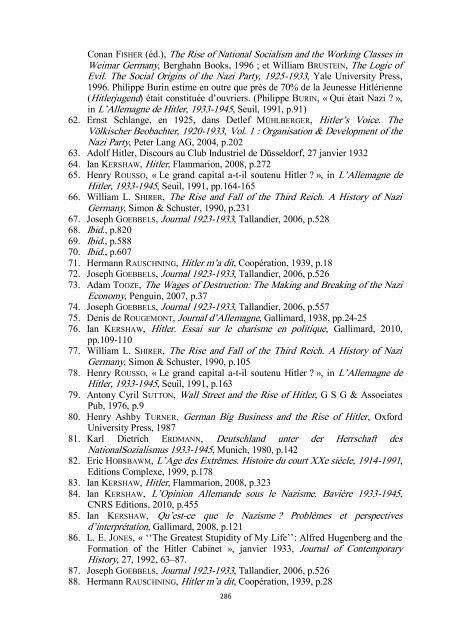Le Socialisme en Chemise Brune - Free
Le Socialisme en Chemise Brune - Free
Le Socialisme en Chemise Brune - Free
Create successful ePaper yourself
Turn your PDF publications into a flip-book with our unique Google optimized e-Paper software.
Conan FISHER (éd.), The Rise of National Socialism and the Working Classes in<br />
Weimar Germany, Berghahn Books, 1996 ; et William BRUSTEIN, The Logic of<br />
Evil. The Social Origins of the Nazi Party, 1925-1933, Yale University Press,<br />
1996. Philippe Burin estime <strong>en</strong> outre que près de 70% de la Jeunesse Hitléri<strong>en</strong>ne<br />
(Hitlerjug<strong>en</strong>d) était constituée d’ouvriers. (Philippe BURIN, « Qui était Nazi ? »,<br />
in L’Allemagne de Hitler, 1933-1945, Seuil, 1991, p.91)<br />
62. Ernst Schlange, <strong>en</strong> 1925, dans Detlef MÜHLBERGER, Hitler’s Voice. The<br />
Völkischer Beobachter, 1920-1933, Vol. 1 : Organisation & Developm<strong>en</strong>t of the<br />
Nazi Party, Peter Lang AG, 2004, p.202<br />
63. Adolf Hitler, Discours au Club Industriel de Düsseldorf, 27 janvier 1932<br />
64. Ian KERSHAW, Hitler, Flammarion, 2008, p.272<br />
65. H<strong>en</strong>ry ROUSSO, « <strong>Le</strong> grand capital a-t-il sout<strong>en</strong>u Hitler ? », in L’Allemagne de<br />
Hitler, 1933-1945, Seuil, 1991, pp.164-165<br />
66. William L. SHIRER, The Rise and Fall of the Third Reich. A History of Nazi<br />
Germany, Simon & Schuster, 1990, p.231<br />
67. Joseph GOEBBELS, Journal 1923-1933, Tallandier, 2006, p.528<br />
68. Ibid., p.820<br />
69. Ibid., p.588<br />
70. Ibid., p.607<br />
71. Hermann RAUSCHNING, Hitler m’a dit, Coopération, 1939, p.18<br />
72. Joseph GOEBBELS, Journal 1923-1933, Tallandier, 2006, p.526<br />
73. Adam TOOZE, The Wages of Destruction: The Making and Breaking of the Nazi<br />
Economy, P<strong>en</strong>guin, 2007, p.37<br />
74. Joseph GOEBBELS, Journal 1923-1933, Tallandier, 2006, p.557<br />
75. D<strong>en</strong>is de ROUGEMONT, Journal d’Allemagne, Gallimard, 1938, pp.24-25<br />
76. Ian KERSHAW, Hitler. Essai sur le charisme <strong>en</strong> politique, Gallimard, 2010,<br />
pp.109-110<br />
77. William L. SHIRER, The Rise and Fall of the Third Reich. A History of Nazi<br />
Germany, Simon & Schuster, 1990, p.105<br />
78. H<strong>en</strong>ry ROUSSO, « <strong>Le</strong> grand capital a-t-il sout<strong>en</strong>u Hitler ? », in L’Allemagne de<br />
Hitler, 1933-1945, Seuil, 1991, p.163<br />
79. Antony Cyril SUTTON, Wall Street and the Rise of Hitler, G S G & Associates<br />
Pub, 1976, p.9<br />
80. H<strong>en</strong>ry Ashby TURNER, German Big Business and the Rise of Hitler, Oxford<br />
University Press, 1987<br />
81. Karl Dietrich ERDMANN, Deutschland unter der Herrschaft des<br />
NationalSozialismus 1933-1945, Munich, 1980, p.142<br />
82. Eric HOBSBAWM, L’Age des Extrêmes. Histoire du court XXe siècle, 1914-1991,<br />
Editions Complexe, 1999, p.178<br />
83. Ian KERSHAW, Hitler, Flammarion, 2008, p.323<br />
84. Ian KERSHAW, L’Opinion Allemande sous le Nazisme. Bavière 1933-1945,<br />
CNRS Editions, 2010, p.455<br />
85. Ian KERSHAW, Qu’est-ce que le Nazisme ? Problèmes et perspectives<br />
d’interprétation, Gallimard, 2008, p.121<br />
86. L. E. JONES, « ‘‘The Greatest Stupidity of My Life’’: Alfred Hug<strong>en</strong>berg and the<br />
Formation of the Hitler Cabinet », janvier 1933, Journal of Contemporary<br />
History, 27, 1992, 63–87.<br />
87. Joseph GOEBBELS, Journal 1923-1933, Tallandier, 2006, p.526<br />
88. Hermann RAUSCHNING, Hitler m’a dit, Coopération, 1939, p.28<br />
286


